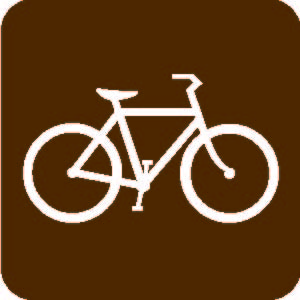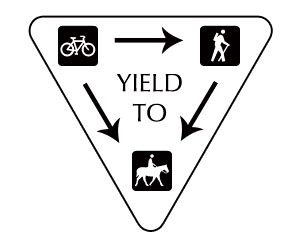Angeles National Forest Mt. Bicycle Guide Brochure

 Welcome to the Angeles National Forest! Mountain bikes are welcome on all trails within the Angeles National Forest except those within a designated Wilderness or on the Pacific Crest National Scenic Trail (which is designated as a footpath and horseback riding trail under the National Trails System Act, 82 Stat. 919). For information on what trails on the Angeles National Forest would be a good match for your level of experience and skill, contact any of the offices listed on this brochure.
Welcome to the Angeles National Forest! Mountain bikes are welcome on all trails within the Angeles National Forest except those within a designated Wilderness or on the Pacific Crest National Scenic Trail (which is designated as a footpath and horseback riding trail under the National Trails System Act, 82 Stat. 919). For information on what trails on the Angeles National Forest would be a good match for your level of experience and skill, contact any of the offices listed on this brochure.
SHARED USE MEANS SHARED RESPONSIBILITY!
Equestrians, pack trains, hunters and hikers have been using trails in the Angeles National Forest for over 100 years. Prior to that, local Native Americans used these trails to travel between the coastal and inland valleys. Now another trail user has arrived on the scene—the mountain bicyclist. Bicycling is a relatively new use of forest trails, and by following a few simple rules, cyclists will prove themselves to be good neighbors to other trail users.
Mountain biking is a challenging sport, offering yet another way to experience the beautiful and ever-changing forest. However, since mountain biking is just one of many recreation uses of National Forest lands, sound conservation practices and respect for the rights of all users is necessary to maintain the positive qualities of the sport.
 Equestrians are concerned about safety because of the differences in travel speeds and the sometimes violent reaction of a horse to an unfamiliar sight on the trail. Some hikers object to the presence of bicyclists for aesthetic reasons as well as safety concerns.
Equestrians are concerned about safety because of the differences in travel speeds and the sometimes violent reaction of a horse to an unfamiliar sight on the trail. Some hikers object to the presence of bicyclists for aesthetic reasons as well as safety concerns.
To provide cyclists with a safe and enjoyable riding experience while addressing the concerns of other user groups, local representatives of hiking, bicycling and equestrian organizations have joined together to draft a code of ethics for cyclists which provides an awareness and understanding of the trail environment. This is in conjunction with the Angeles National Forest Land and Resource Management Plan.

CYCLIST’S RESPONSIBILITY CODE

This code has been adapted from excerpts from the NORBA Cyclist Code, and is used by permission of the National Off-road Bicycle Association, Solvang, Calif.
Yield right-of-way to other trail users. Horses are often nervous, and may spook when they see an unfamiliar object, especially one which moves quickly and quietly. Please use caution when approaching or passing, especially from behind. Be sure to warn the rider of your presence. If necessary, dismount and wait for the horse and rider to pass or signal you through. Realize that people judge all cyclists by your actions.
Control your speed at all times and approach turns in anticipation of someone around the bend. Reckless riding and high downhill speeds are not appropriate. Careless or reckless riding without regard for the safety of any person or in a manner that endangers or is likely to endanger any person or property is punishable by fine (36CFR261.13(g)).
Slow down and use caution when passing others. If necessary, dismount your bicycle on the downhill side and wait for horses and hikers to pass.
Stay on designated roads and trails to avoid trampling native vegetation and creating wheel ruts that can channel water and cause erosion. Cross country travel is prohibited.
Never ride alone! Always leave word with someone on where you plan to go, your route of travel and your anticipated time of return.
Stay off muddy trails and do not cut across switch backs. This will minimize soil erosion and protect the trail resource.
Do not disturb wildlife or livestock.
Do not litter. Pack out what you pack in and more, whenever possible. Have pride in your forest and try to leave it cleaner than you found it.
Observe signs prohibiting bicycle use. Some trails cross private property and are subject to deed restrictions which prohibit all vehicular travel.
Respect public and private property by practicing minimum impact cycling.
Leave closed gates closed and open gates open.
THINGS TO REMEMBER BE PREPARED!
Each ride should be determined by your ability, equipment, terrain and weather conditions. Remember—weather and trail conditions change continuously.
Know forest rules by checking with your local Forest Service office regarding regulations and current trail status for bicycles.
Poison oak grows abundantly in many parts of the forest. Learn to identify and avoid this plant. Its waxy leaflets grow in lobes of three, and change from green to red or maroon in the fall.
Rattlesnakes are also common throughout the area. Most of the time they will make an effort to get out of your way. If cornered or surprised, however, they may strike. Watch your step—especially when traveling through rocky areas or heavy brush.
Water bars may be hazardous to cyclists, so please be aware of water bars on trails. Damaging or traveling around constructed water bars increases the potential for trail erosion and requires additional maintenance. Please keep a slow speed and enjoy your surroundings.
FIRE REGULATIONS
Dry weather and dense vegetation make wildfire a year-round threat. Your help is needed to preserve these lands from the ravages of wildfire. While in the forest Remember!
Smoking is allowed only in buildings and vehicles, within developed recreation sites, or in areas that are cleared of flammable vegetation for a minimum of five feet. Please use your ashtray!
The possession or use of fireworks is prohibited.
Open wood fires and barbecues are not permitted outside developed Forest Service campgrounds and picnic areas.
Only portable stoves using gas, jellied petroleum or pressurized liquid fuel may be used outside developed sites, and a California Campfire Permit is required for their use. A California Campfire Permit is free and may be obtained at any Forest Service office. During extreme fire danger, additional fire restrictions may be in effect. Check with any Forest Service office for current fire restriction information.
Campfire permits are not required at developed Forest Service campgrounds or picnic areas. You may use the site provided stoves, fire pits or campfire circles or your own portable barbecue or liquid/gas fuel stove. Wood and charcoal fires are allowed but must be contained in stoves. Visitor built “rock ring” campfires are not allowed.
Make your campfire safe! You need to have a shovel or hand trowel, and must clear the area around your fire for a minimum of five feet in each direction. Keep your fire small, never leave it unattended, and above all, be sure it is dead out before you leave. Collecting firewood is limited to that already dead on the ground.
Safe all terrain cycling requires the knowledge of your own ability and your equipment, as well as being prepared for the unexpected. Be prepared and equipped to look after yourself and your bike. Your needs will differ depending upon where you ride and the type of riding you do.
SUGGESTED ITEMS TO TAKE ON YOUR RIDE:
- Topographical map of area
- Wire
- Compass
- First Aid Kit
- Whistle
- Fiber Tape
- Cable
- Extra food & clothing
- Specialty wrenches as needed for Allen bolts, axles, etc.
Remember to notify family or friends where you are going and when you expect to return!
VOLUNTEERING
The rising cost of managing and maintaining public lands threatens the quality and number of recreational opportunities available. Volunteers can help offset these costs and promote cooperation among all trail users. Many forest trails are maintained by local volunteers who help support their own sport while simultaneously providing a valuable public service.
Volunteering offers an opportunity to serve as a member of the trail family by contributing an equal share of the work needed to keep the trails open. If you or your club are interested in volunteering or need more information, contact one of the offices listed below.
Los Angeles River Ranger District
12371 N. Little Tujunga Canyon Road
San Fernando, CA 91342
(818) 899-1900
CRS (800) 735-2922 (Voice)
CRS (800) 735-2929 (TDD/TTY)
San Gabriel River Ranger District
110 N. Wabash Avenue
Glendora, CA 91741
(626) 335-1251
CRS (800) 735-2922 (Voice)
CRS (800) 735-2929 (TDD/TTY)
Santa Clara/Mojave Rivers Ranger District
33708 Crown Valley Road
Acton, CA 93510
(661) 269-2808
Fax: (661) 296-2825
CRS (800) 735-2922 (Voice)
CRS (800) 735-2929 (TDD/TTY)
Issued 5/11
Alerts & Warnings
- NEW! Office & Visitor Center Updates - Need Info or Passes?
- UPDATED Closure: Small Section of the Forest Still Closed due to Bobcat Fire
- Fire Danger Increases to ‘MODERATE’ at the Angeles National Forest
- Advisory: Hiking at High Elevations
- Driving to the Forest?
- Forest Service Road Closures
- Closure: West Fork Road to recreationists on weekdays thru Dec. 1, 2024
- Closure: San Gabriel Reservoir Area thru June 30, 2024
- Planning to Camp? (Stay Limits/Dispersed Camping Restrictions) til Dec. 15, 2024

